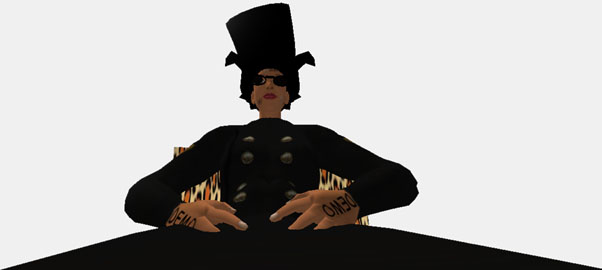

Gazira Babeli
Code Performer
| Hammering The Void |
| Domenico Quaranta, May 2009 |
|
"The world we actually have does not meet my standards."
In 1920, at the opening of a Dada exhibition in Kln, Max Ernst made an axe available for the audience. As far as I know, this gesture was never reenacted. That's a shame. An artwork should always come with an axe in attach. This would remind us that art must be loved, or hated. That it deserves more than an idiot gaze. Duchamp took years to make us accept his urinal, yet he's still unable to persuade us to use it in the more logical way: pissing into it. I bet he would be happy of this kind of interaction: turning an artwork into an urinal. Gazira Babeli never reenacts - she acts. She's worshipped as a marabout, but she hates spells and she does her best to break them. Tell her "aura" and she'll throw an hail of meteoroids onto you. Tell her "virtual" and she'll shoot you into the air at 900 km/h. When, in 2006, she made Come To Heaven, she released the code of the performance through her website: she discovered the painful delights of being beaten up by a computer graphics card, and she wanted to share this feeling with everybody. Yet, even on a computer screen, people keep on loving the moonlight instead of killing it, and being charmed by everything is introduced to them as "art". Thus Gazira created the fourteen sisters. They are called Anger Erin, Envy Sixpence, Gluttony Aboma, Greed Petrovic, Lust Placebo, Pride Placebo, Sloth Swansong, Courage Sparta, Faith Radikal, Hope Varnish, Justice Kimono, Love Brandi, Prudence Miami, Temperance Navarita. They are Gazira Babeli, fourteen times. Carrying a wooden sledge-hammer, they move all together, and hit violently. When you, beloved art lover, meet them, feel free to think at the following references, at your pleasure: La Liberté Guidant le Peuple, The Night Watch, Il quarto stato, an army of models performing Vanessa Beecroft. At your first blow on the head, art will be replaced, in your mind, by castor oil and gas chambers. This platoon in Wellington boots and suspender belt comes without any notice, and intervenes in social events - mostly exhibition openings - making a hell of a mess. Is this the usual, boring self-referential crap we are used to find in art? What Gazira likes is to intervene in the rituality of the real, and break up its continuity. The world she actually has does not meet her standards, and she hammers it. She works in this direction from the very beginning: just think to her earthquakes, her showers of pop bananas, her Campbell's Soup cans, her pizzas fouling up the gallery with tomato soup. Isn't she arse-hole? If you need, Gazira's hammers are there for you. Use them, against her too. That's what she wants. Postscript When they are not swooping down on some crowd trying to smash an artist's head, Gazira's Furies are imprisoned in a claustrophobic office with a view on Windows' standard desktop, jumping around all the time. The office is encaged in a computer. The computer is encaged in a gallery. Gaz' en valise, finally. It looks like a storm in a glass snowball, until you don't open it. And it comes with an hammer, of course. |
Back to TEXTS |
